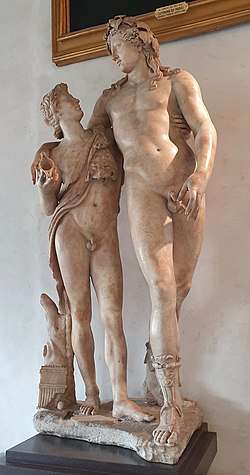Ampelos
Ampelos (Greek: Ἂμπελος, lit. "Vine") or Ampelus (Latin) was a personification of the grapevine and lover of Dionysus[1] in Greek and Roman mythology. He was a satyr that either turned into a Constellation or the grape vine, due to Dionysus.

Nonnus
In Nonnus's etiology, Ampelos is a beautiful satyr youth, who was loved by Dionysus, and whose death was foreseen by the god. There are two versions of his death and Dionysus's reaction to it. According to Nonnus, Ampelos was gored to death by a wild bull after he mocked the goddess Selene, a scene described as follows:
- "[Ampelos, love of Dionysos, rode upon the back of a wild bull:] He shouted boldly to the fullfaced Moon (Mene)—‘Give me best, Selene, horned driver of cattle! Now I am both—I have horns and I ride a bull!’
- So he called out boasting to the round Moon. Selene looked with a jealous eye through the air, to see how Ampelos rode on the murderous marauding bull. She sent him a cattlechasing gadfly; and the bull, pricked continually all over by the sharp sting, galloped away like a horse through pathless tracts [it then threw and gored him to death]"[2]
Upset by his death, Dionysus transformed Ampelos's body into the first grape vine and created wine from his blood.
Ovid
The second version involves grape vines in a different manner. According to Ovid:
Dryad
Various ampelose—also "Ampelos" in the singular—also appear in Greek mythology a variety of hamadryad.
References
- "AMPELOS - Grape-Vine Satyr of Greek Mythology". www.theoi.com. Retrieved 2020-06-22.
- Nonnus, Dionysiaca 11. 185 ff
- Ovid Fasti 3. 407 ff